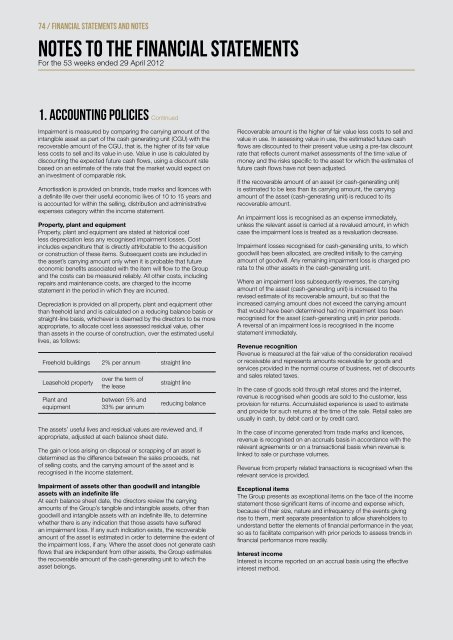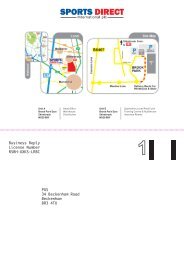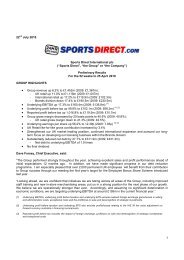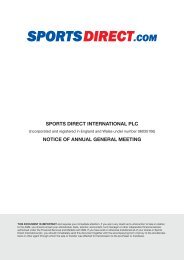Dave Forsey Chief Executive 19 July 2012 - Sports Direct International
Dave Forsey Chief Executive 19 July 2012 - Sports Direct International
Dave Forsey Chief Executive 19 July 2012 - Sports Direct International
You also want an ePaper? Increase the reach of your titles
YUMPU automatically turns print PDFs into web optimized ePapers that Google loves.
74 / FINANCIAL STATEMENTS AND NOTES<br />
notes to the Financial Statements<br />
For the 53 weeks ended 29 April <strong>2012</strong><br />
1. Accounting policies Continued<br />
Impairment is measured by comparing the carrying amount of the<br />
intangible asset as part of the cash generating unit (CGU) with the<br />
recoverable amount of the CGU, that is, the higher of its fair value<br />
less costs to sell and its value in use. Value in use is calculated by<br />
discounting the expected future cash flows, using a discount rate<br />
based on an estimate of the rate that the market would expect on<br />
an investment of comparable risk.<br />
Amortisation is provided on brands, trade marks and licences with<br />
a definite life over their useful economic lives of 10 to 15 years and<br />
is accounted for within the selling, distribution and administrative<br />
expenses category within the income statement.<br />
Property, plant and equipment<br />
Property, plant and equipment are stated at historical cost<br />
less depreciation less any recognised impairment losses. Cost<br />
includes expenditure that is directly attributable to the acquisition<br />
or construction of these items. Subsequent costs are included in<br />
the asset’s carrying amount only when it is probable that future<br />
economic benefits associated with the item will flow to the Group<br />
and the costs can be measured reliably. All other costs, including<br />
repairs and maintenance costs, are charged to the income<br />
statement in the period in which they are incurred.<br />
Depreciation is provided on all property, plant and equipment other<br />
than freehold land and is calculated on a reducing balance basis or<br />
straight-line basis, whichever is deemed by the directors to be more<br />
appropriate, to allocate cost less assessed residual value, other<br />
than assets in the course of construction, over the estimated useful<br />
lives, as follows:<br />
Freehold buildings 2% per annum straight line<br />
Leasehold property<br />
Plant and<br />
equipment<br />
over the term of<br />
the lease<br />
between 5% and<br />
33% per annum<br />
straight line<br />
reducing balance<br />
The assets’ useful lives and residual values are reviewed and, if<br />
appropriate, adjusted at each balance sheet date.<br />
The gain or loss arising on disposal or scrapping of an asset is<br />
determined as the difference between the sales proceeds, net<br />
of selling costs, and the carrying amount of the asset and is<br />
recognised in the income statement.<br />
Impairment of assets other than goodwill and intangible<br />
assets with an indefinite life<br />
At each balance sheet date, the directors review the carrying<br />
amounts of the Group’s tangible and intangible assets, other than<br />
goodwill and intangible assets with an indefinite life, to determine<br />
whether there is any indication that those assets have suffered<br />
an impairment loss. If any such indication exists, the recoverable<br />
amount of the asset is estimated in order to determine the extent of<br />
the impairment loss, if any. Where the asset does not generate cash<br />
flows that are independent from other assets, the Group estimates<br />
the recoverable amount of the cash-generating unit to which the<br />
asset belongs.<br />
Recoverable amount is the higher of fair value less costs to sell and<br />
value in use. In assessing value in use, the estimated future cash<br />
flows are discounted to their present value using a pre-tax discount<br />
rate that reflects current market assessments of the time value of<br />
money and the risks specific to the asset for which the estimates of<br />
future cash flows have not been adjusted.<br />
If the recoverable amount of an asset (or cash-generating unit)<br />
is estimated to be less than its carrying amount, the carrying<br />
amount of the asset (cash-generating unit) is reduced to its<br />
recoverable amount.<br />
An impairment loss is recognised as an expense immediately,<br />
unless the relevant asset is carried at a revalued amount, in which<br />
case the impairment loss is treated as a revaluation decrease.<br />
Impairment losses recognised for cash-generating units, to which<br />
goodwill has been allocated, are credited initially to the carrying<br />
amount of goodwill. Any remaining impairment loss is charged pro<br />
rata to the other assets in the cash-generating unit.<br />
Where an impairment loss subsequently reverses, the carrying<br />
amount of the asset (cash-generating unit) is increased to the<br />
revised estimate of its recoverable amount, but so that the<br />
increased carrying amount does not exceed the carrying amount<br />
that would have been determined had no impairment loss been<br />
recognised for the asset (cash-generating unit) in prior periods.<br />
A reversal of an impairment loss is recognised in the income<br />
statement immediately.<br />
Revenue recognition<br />
Revenue is measured at the fair value of the consideration received<br />
or receivable and represents amounts receivable for goods and<br />
services provided in the normal course of business, net of discounts<br />
and sales related taxes.<br />
In the case of goods sold through retail stores and the internet,<br />
revenue is recognised when goods are sold to the customer, less<br />
provision for returns. Accumulated experience is used to estimate<br />
and provide for such returns at the time of the sale. Retail sales are<br />
usually in cash, by debit card or by credit card.<br />
In the case of income generated from trade marks and licences,<br />
revenue is recognised on an accruals basis in accordance with the<br />
relevant agreements or on a transactional basis when revenue is<br />
linked to sale or purchase volumes.<br />
Revenue from property related transactions is recognised when the<br />
relevant service is provided.<br />
Exceptional items<br />
The Group presents as exceptional items on the face of the income<br />
statement those significant items of income and expense which,<br />
because of their size, nature and infrequency of the events giving<br />
rise to them, merit separate presentation to allow shareholders to<br />
understand better the elements of financial performance in the year,<br />
so as to facilitate comparison with prior periods to assess trends in<br />
financial performance more readily.<br />
Interest income<br />
Interest is income reported on an accrual basis using the effective<br />
interest method.



![Our ref: [ ] - Sports Direct International](https://img.yumpu.com/19248141/1/184x260/our-ref-sports-direct-international.jpg?quality=85)





![Our ref: [ ] - Sports Direct International](https://img.yumpu.com/18440214/1/184x260/our-ref-sports-direct-international.jpg?quality=85)

